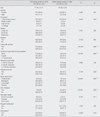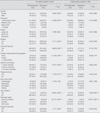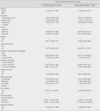Abstract
Purpose
This study was to investigate the prevalence of depressive symptoms and risk factors in elderly people (old vs oldest-old) with arthritis.
Methods
The Korean Longitudinal Study of Aging (KLoSA) was used with a sample of 1,084 elderly people with arthritis aged 65 or above.
Results
We found that the prevalence of depressive symptom was greater for oldest-old people (66.7%) compared to old people (56%). Significant differences between old people and oldest-old people were found for education, living with spouse, number of generation, regular exercise, body mass index (BMI), ADL limitation, self-rated health, and depression. Significant differences existed between depression and non-depression in terms of all variables except region and BMI among old people. But, among the oldest people, ADL limitation and self-rated health showed differences. The Logistic regression analysis revealed that religion, medical comorbidity, ADL limitation, self-rated health were significantly associated with depressive symptoms in old people. But, in oldest-old people, none of the variables were associated with depressive symptoms.
Conclusion
The findings show that there are age differences in depression and related factors in elderly people with arthritis. Longitudinal studies, which covered depressive symptom severity and which are controlled for a large number of potential confounders, will need to complement the results of this study in the future.
Figures and Tables
References
1. Blazer DG. Psychiatry and the oldest old. The American Journal of Psychiatry. 2000. 157:1915–1924.
2. Bonin-Guillaume S, Hasbroucq T, Blin O. Psychomotor retardation associated to depression differs from that of normal aging. Psychologie & Neuropsychiatrie du Vieillissement. 2008. 6:137–144.
3. Bruce TO. Comorbid depression in rheumatoid arthritis: Pathophysiology and clinical implications. Current Psychiatry Reports. 2008. 10:258–264.
4. Choi NG, Kim JS. Age group differences in depressive symptoms among older adults with functional impairments. Health & Social Work. 2007. 32:177–188.
5. Chou KL, Chi I. Prevalence and correlates of depression in Chinese oldest-old. International Journal of Geriatric Psychiatry. 2005. 20:41–50.
6. Chu SK, Yoo JH, Lee CY. The effects of a cognitive behavior program on cognition, depression, and activities of daily living in elderly with cognitive impairment. Journal of Korean Academy of Nursing. 2007. 37:1049–1060.
7. Gazmararian J, Baker D, Parker R, Blazer DG. A multivariate analysis of factors associated with depression: Evaluating the role of health literacy as a potential contributor. Archives of Internal Medicine. 2000. 160:3307–3314.
8. Irwin M, Artin KH, Oxman MN. Screening for depression in the older adult: Criterion validity of the 10-item Center for Epidemiological Studies Depression Scale (CES-D). Archives of Internal Medicine. 1999. 159:1701–1704.
9. Kang IO, Yun YH. Preliminary investigation of the quality of life in the elderly with cancer. Journal of Korean Academy of Family Medicine. 2004. 25:678–686.
10. Ki BS, Choi IG, Han JH. Depression in older patients. Biological Research Information Center BioWave. 2004. 6:1–17.
11. Kim KB, Yun JH, Sok SR. Effects of Individual Reminiscence Therapy on Older Adults' Depression, Morale and Quality of Life. Journal of Korean Academy of Nursing. 2006. 36:813–820.
12. Kim SY, Won CW, Rho YG. The validity and reliability of Korean version of Barthel ADL Index. Journal of Korean Academy of Family Medicine. 2004. 25:534–541.
13. Kivinen P, Halonen P, Eronen M, Nissinen A. Self-rated health, physician-rated health and associated factors among elderly men: The Finnish cohorts of the seven countries studies. Age and Ageing. 1998. 27:41–47.
14. Korean longitudinal study of aging. Korea Labor Institute. 2008. 09. Retrieved September 23, 2008. from http://klosa.kli.re.kr.
15. Population projections for Korea: 2005-2050 based on the 2005 census. Korea National Statistical Office. 2006. 05. Retrieved September 4, 2008. from http://www.kosis.kr/search/totalSearch2.jsp.
16. McDougall FA, Matthews FE, Kvaal K, Dewey ME, Brayne C. Prevalence and symptomatology of depression older people living in institutions in England and Wales. Age and Aging. 2007. 36:562–568.
17. Mills TL. Comorbid depressive symptomatology: Isolating the effects of chronic medical conditions on self-reported depressive symptoms among community-dwelling older adults. Social Science & Medicine. 2001. 53:569–578.
18. Nakajima A, Kamitsuji S, Saito A, Tanaka E, Nishimura K, Horikawa N, et al. Disability and patient's appraisal of general health contribute to depressed mood in rheumatoid arthritis in a large clinical study in Japan. Modern rheumatology. 2006. 16:151–157.
19. Niti M, Ng TP, Kua EH, Ho RC, Tan CH. Depression and chronic medical illnesses in Asian older adults: The role of subjective health and functional status. International Journal of Geriatric Psychiatry. 2007. 22:1087–1094.
20. Penninx BW, Beekman AT, Deeg DJ, Van Tilburg W. Effects of depression on physical health and mortality in the elderly. Longitudinal results of the LASA research. Tijdschrift voor Gerontologie en Geriatrie. 2000. 31:211–218.
21. Penninx BW, Beekman AT, Ormel J, Kriegsman DM, Boeke AJ, Van Eijk J, et al. Psychological status among elderly people with chronic diseases: Does type of disease play a part? Journal of Psychosomatic Research. 1996. 40:521–534.
22. Radloff LS. Anonymous applied psychological measurement: The CES-D Scale: A self-report depression scale for research in the general population. 1977. New York, NY: West Publishing.
23. Rapp MA, Gerstorf D, Helmchen H, Smith J. Depression predicts mortality in the young old, but not in the oldest old: Results from the Berlin Aging Study. The American Journal of Geriatric Psychiatry. 2008. 16:844–852.
24. Rivard V, Cappeliez P. Perceived control and coping in woman faced with activity restriction due to osteoarthritis: Relations to anxious and depressive symptoms. Canadian Journal on Aging. 2007. 26:241–253.
25. Seo NS, Chung YH, Kim JS. Factors related to quality of life among rural elderly. Journal of Korean Academy of Adult Nursing. 2005. 17:379–388.
26. Stek ML, Gussekloo J, Beekman AT, Van Tilburg W, Westendorp RG. Prevalence, correlates and recognition of depression in the oldest old: The Leidon 85-plus study. Journal of Affective Disorders. 2004. 78:193–200.
27. Stek ML, Vinkers DJ, Gussekloo J, Van Der Mast RC, Beekman AT, Westendorp RJ. Natural history of depression in the oldest old: Population-based prospective study. The British Journal of Psychiatry. 2006. 188:65–69.
28. Sung KW, Kim MH. Self-care behaviors and depressive symptoms of low-income elderly woman with hypertension. Journal of Korean Academy of Nursing. 2008. 38:593–602.
29. World population prospects: the 2006 revision. United Nations, New York. 2007. 03. Retrieved October 6, 2008. from http://www.un.org/esa/population/publications/wpp2006/wpp2006.htm.
30. Weyerer S, Eifflaender-Gorfer S, Kohler L, Jeesen F, Maier W, Fuchs A, et al. Prevalence and risk factors for depression in non-demented primary care attenders aged 75 years and older. Journal of Affective Disorders. 2008. 111:153–163.




 PDF
PDF ePub
ePub Citation
Citation Print
Print





 XML Download
XML Download